Author: Matt Del Fiacco
Whether a homebrewer entering their beer in a competition or a professional brewer distributing their product to market, flavor stability has long been a challenge faced by both. When it comes to beer staling, the most commonly cited culprit is oxidation, the reduction of which has led to the development of sophisticated mechanical solutions involving the packaging and shipping process.
However, a relatively new product to hit scene offers a chemical option that promises to reduce oxidative effects on beer, thereby improving shelf stability, while also hastening clarification. Previously known as Tanal B, BrewTan B is described by its Japanese manufacturer, Ajinomoto, as:
100% natural gallotannins specially designed for the brewing industry. These tannins react with the haze sensitive proteins (proteins rich in proline) and SH-group containing proteins by adsorption and precipitation. In addition to interacting with these proteins, the Brewtan products are able to chelate iron. This results in the inhibition of the Fenton oxidation reaction.
On a general level, homebrewer packaging processes are often rife with vectors for oxidation, and many of us also use chillers made of copper, which while beneficial to yeast, may encourage oxidative reaction that negatively impact beer flavor stability. When I heard about BrewTan B, which is relatively inexpensive, would help with these issues while also improving the clarity of my beer, I was excited to try it out for myself!
| PURPOSE |
To evaluate the differences between a Pale Ale treated with Brewtan B during both the mash and the boil and one that was untreated.
| METHODS |
Seeing as hoppier styles tend to lose their freshness fairly quickly, and having recently brewed more malt-forward beers, I went with a classic American Pale Ale for this xBmt.
Settle Down Pale Ale
Recipe Details
| Batch Size | Boil Time | IBU | SRM | Est. OG | Est. FG | ABV |
|---|---|---|---|---|---|---|
| 4.5 gal | 60 min | 36.1 IBUs | 5.2 SRM | 1.048 | 1.013 | 4.6 % |
| Actuals | 1.048 | 1.013 | 4.6 % | |||
Fermentables
| Name | Amount | % |
|---|---|---|
| Pale Malt (Weyermann) | 8 lbs | 96.24 |
| Munich I (Weyermann) | 5 oz | 3.76 |
Hops
| Name | Amount | Time | Use | Form | Alpha % |
|---|---|---|---|---|---|
| Caliente | 4 g | 60 min | Boil | Pellet | 16.8 |
| Caliente | 9 g | 20 min | Boil | Pellet | 16.8 |
| Caliente | 22 g | 5 min | Boil | Pellet | 16.8 |
| Caliente | 75 g | 3 days | Dry Hop | Pellet | 16.8 |
Yeast
| Name | Lab | Attenuation | Temperature |
|---|---|---|---|
| Flagship (A07) | Imperial Yeast | 75% | 60°F - 72°F |
Notes
| Water Profile: Ca 80 | Mg 2 | Na 10 | SO4 125 | Cl 62 |
Download
| Download this recipe's BeerXML file |
A few days before brew day, I spun up a starter of Imperial Yeast A07 Flagship, a strain not particularly known for high flocculation.
I kicked off my brew day by gathering my water and turning the temperature controllers on my systems on to heat the liquor.
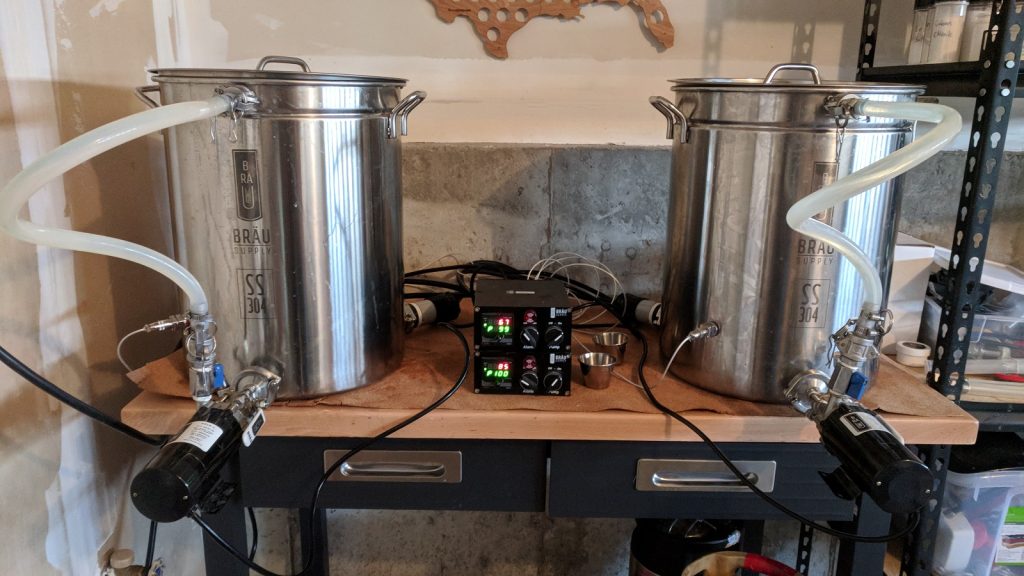
I adjusted the water profile of both batches then weighed out and milled the grain.
I mashed in the standard batch before focusing on the BrewTan B batch. There’s some variance on the recommended amount of BrewTan B, but for the purposes of the xBmt, I thought it best to stick with middle range of the manufacturer recommendation. After measuring it out, I dissolved the BrewTan B in some water and added it to the strike water.
When the BrewTan B was fully incorporated, I mashed in. Both mashes were continuously recirculated and they were held at the same temperature.
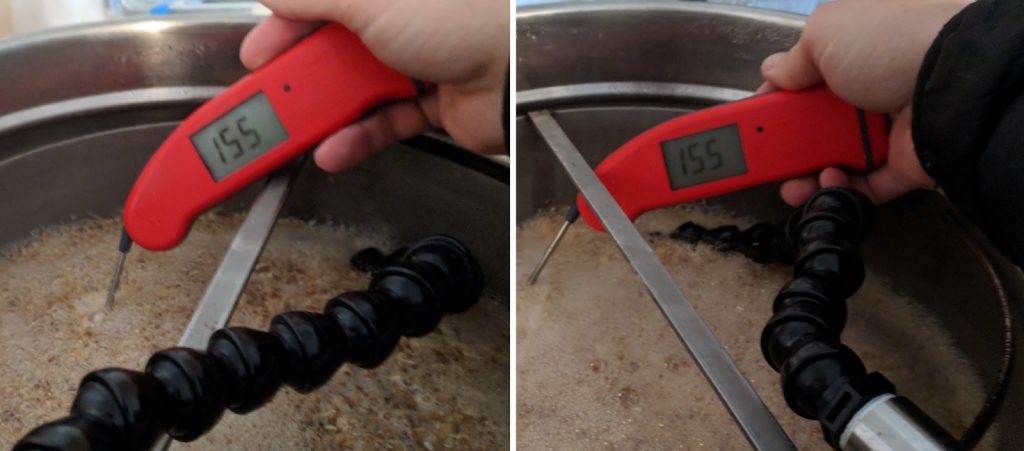
I noticed the foam produced by the agitation from recirculation was more stable on in the BrewTan B mash.
After each 60 minute mash, I removed the grains and began heating the worts, measuring out the hops for both batches while waiting to reach a boil.
Since BrewTan B is said to improve beer clarity, I left out my usual addition of Whilflocc during the 60 minute boil. With 5 minutes left in the boil, I dissolved another 1 gram of BrewTan B in water then added to its respective wort. It seemed the foam on the BrewTan B batch had a subtle pink shade to it, unlike the standard wort.
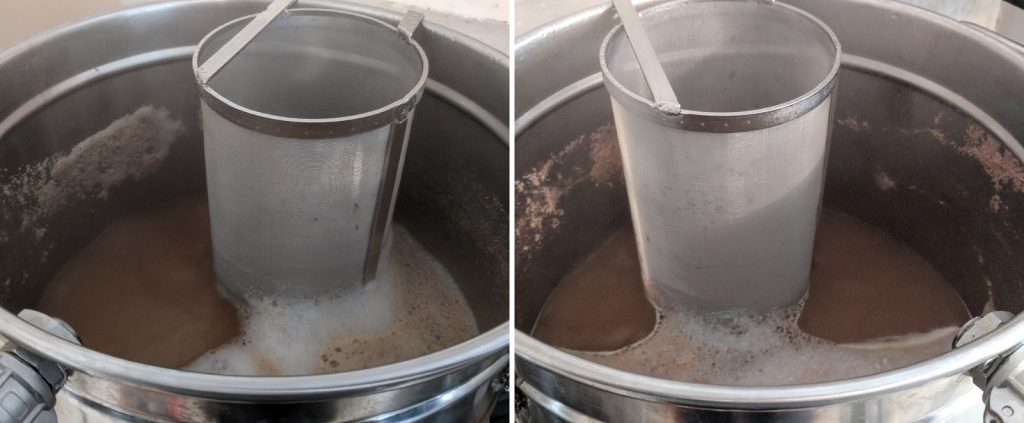
Once each boil was complete, I quickly chilled the wort with my CFC, collecting identical amounts of chilled wort from either batch in glass carboys.
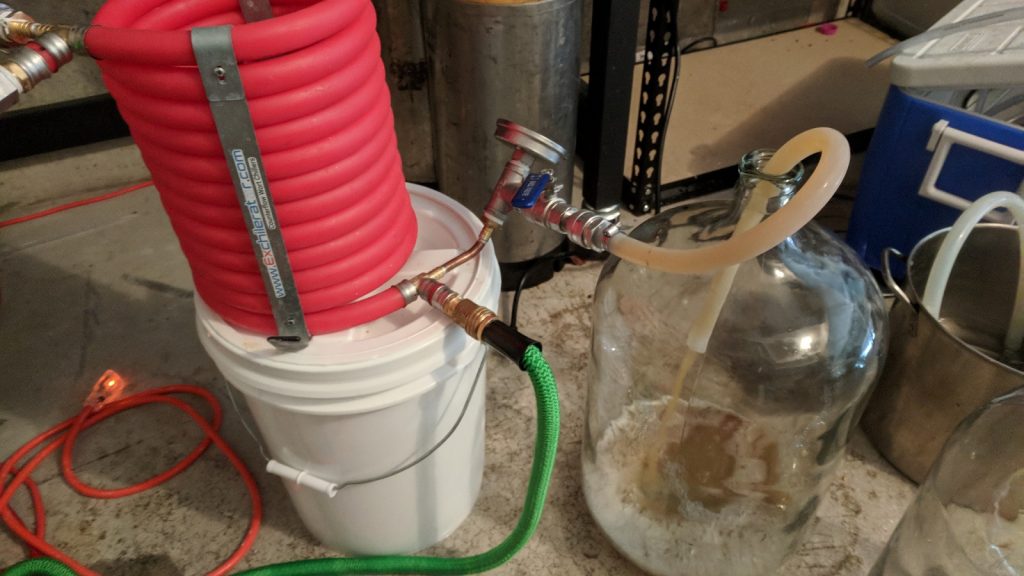
I noticed the trub in the bottom of either kettle look quite different, almost as if the BrewTan B encouraged more break formation.
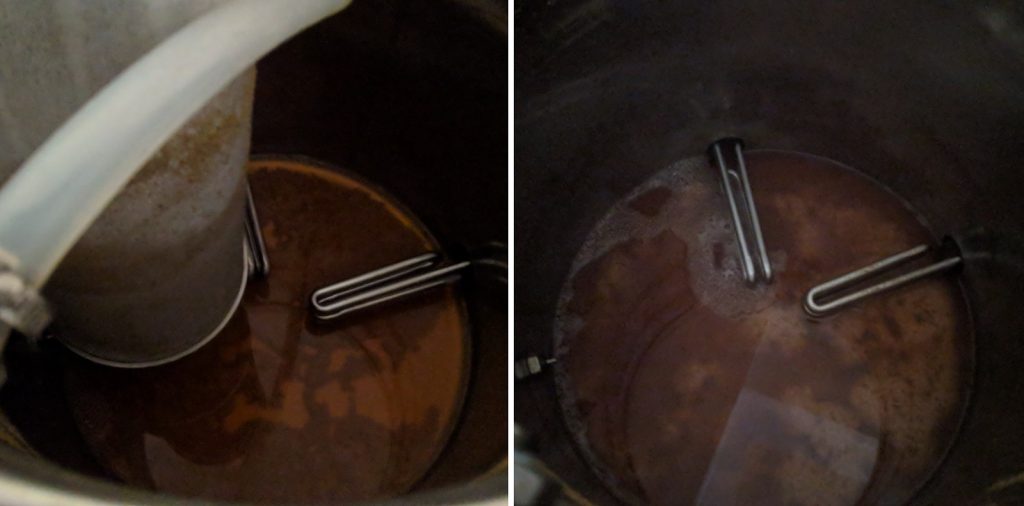
Hydrometer measurements showed the BrewTan B wort was slightly higher than the standard wort.
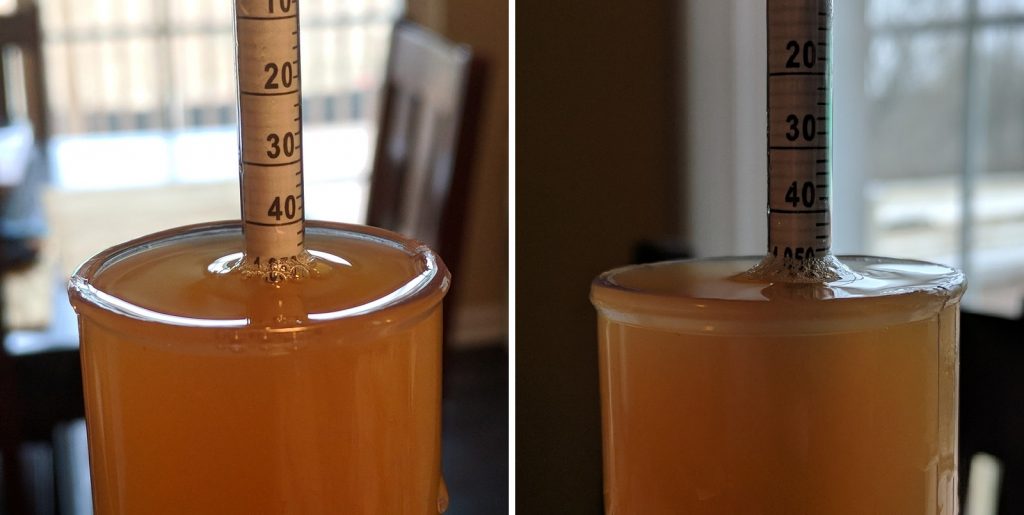
I let the worts sit in my chamber until they cooled to my target pitching temperature of 64°F/18°C before pitching the yeast. Signs of activity were observed just 7 hours later.
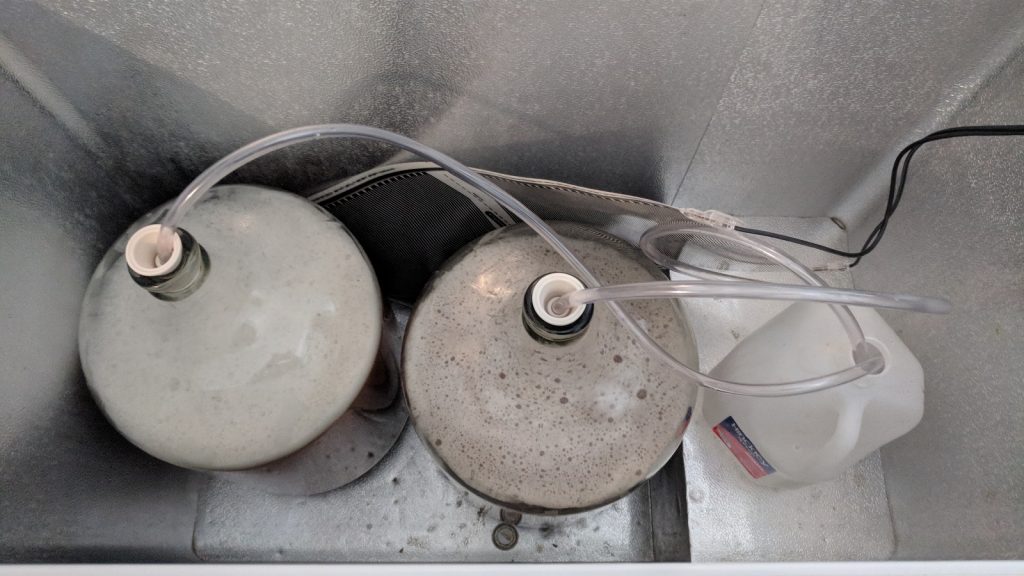
The beers fermented for a week before I added the dry hop additions, after which I left them alone for another 3 days before cold crashing. Hydrometer measurements at this time confirmed both beers had reached the same FG.
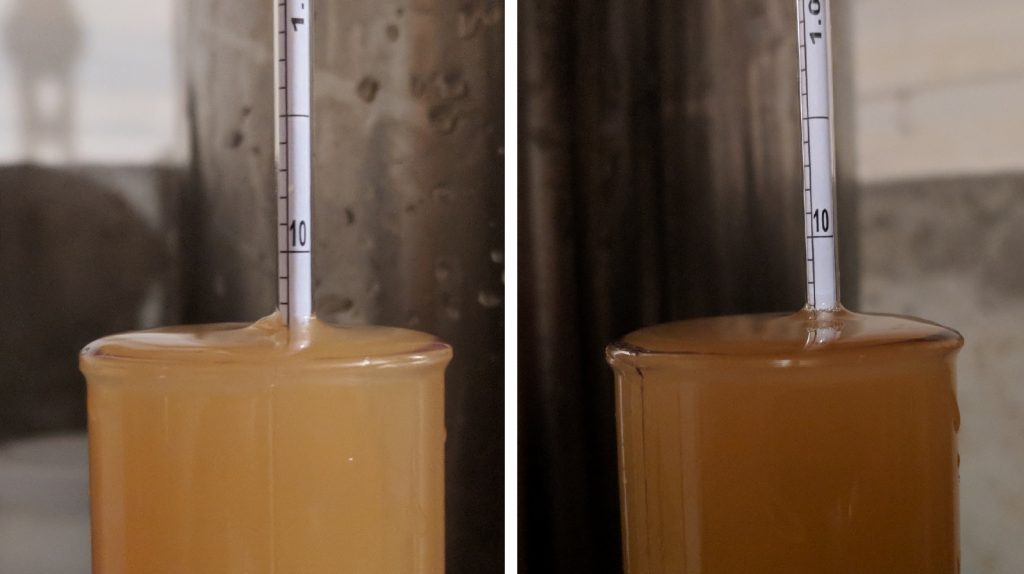
When it came time to keg, I noticed the standard beer had a touch more trub than the BrewTan B beer, which had a slightly lighter colored kräusen ring.
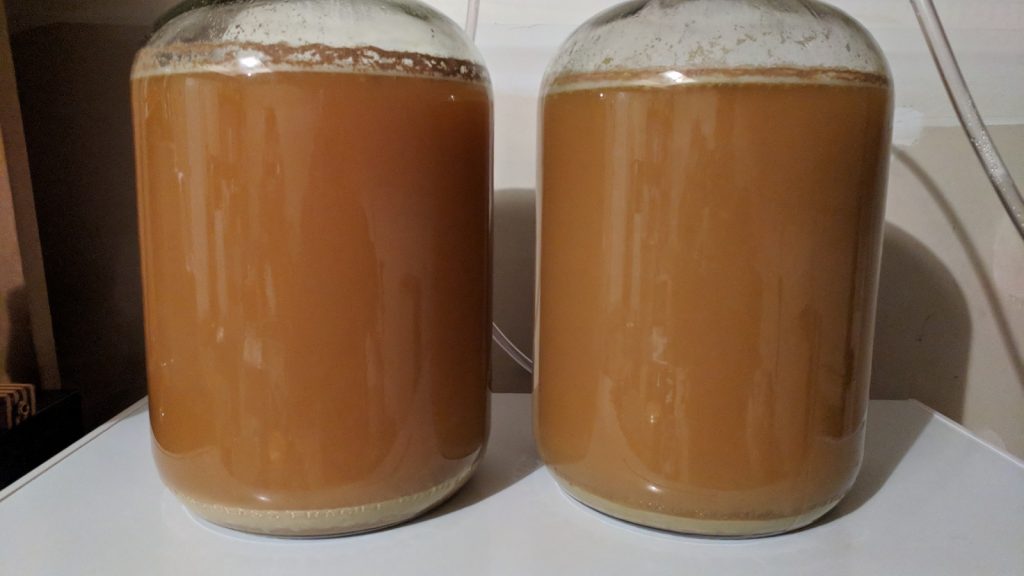
I transferred each batch to sanitized and CO2 purged kegs.
The beers were placed in my kegerator and burst carbonated. Curiously, even after a week in the cool environment, both beers maintain a noticeable haze.
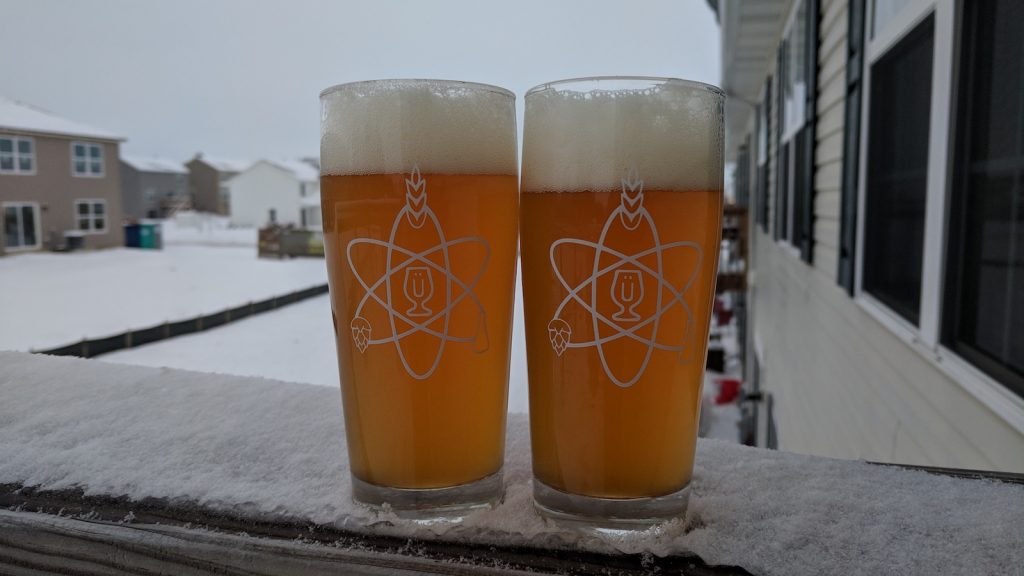
| RESULTS |
 A special thanks to the Plainfield Ale and Lager Enthusiasts for inviting me to collect data for this xBmt a recent club meeting, great group of brewers! this meeting to gather some data! A total of 27 people of varying levels of experience participated in this xBmt. Each participant was served 2 samples of the BrewTan B beer and 1 sample of the standard beer in different colored opaque cups then asked to identify the sample that was unique. At this sample size, 14 tasters (p<0.05) would have had to select the unique sample in order to reach statistical significance, and that is exactly the number who made the correct selection (p=0.037), indicating participants were able to reliably distinguish a Pale Ale treated with BrewTan B in both the mash and the boil from one the was untreated.
A special thanks to the Plainfield Ale and Lager Enthusiasts for inviting me to collect data for this xBmt a recent club meeting, great group of brewers! this meeting to gather some data! A total of 27 people of varying levels of experience participated in this xBmt. Each participant was served 2 samples of the BrewTan B beer and 1 sample of the standard beer in different colored opaque cups then asked to identify the sample that was unique. At this sample size, 14 tasters (p<0.05) would have had to select the unique sample in order to reach statistical significance, and that is exactly the number who made the correct selection (p=0.037), indicating participants were able to reliably distinguish a Pale Ale treated with BrewTan B in both the mash and the boil from one the was untreated.
The 14 participants who made the accurate selection on the triangle test were instructed to complete a brief preference survey comparing only the 2 beers that were different. A total of 4 reported preferring the standard beer, 3 liked the BrewTan B beer more, 5 reported having no preference despite noticing a difference, and 2 perceived no difference between the beers.
My Impressions: Despite my best attempts, I simply couldn’t tell these beers apart in multiple triangle tests. I perceived both as being a bit bland in malt character with noticeable citrus and stone fruit hop characteristics.
| DISCUSSION |
There are two main things BrewTan B is said to have an impact on, one of which the triangle test doesn’t test for– clarity. After observing the seemingly chunkier kettle trub in the batch dosed with BrewTan B, it was obvious something was happening and that this might lead to differences later on down the line. However, the finished beers maintained a very similar appearance, suggesting the BrewTan B didn’t have the expected effect on clarity.
The other issue BrewTan B is said to address is wort staling, which leads to reduced shelf stability. In discussing the design of this xBmt with the crew, we thought it’d be interesting to perform an initial test using a hoppy ale served relatively fresh, which I admittedly expected to return a non-significant result. The fact participants were able to reliably tell apart the beer dosed with BrewTan B from the untreated beer, assuming the result isn’t a false positive, suggests the chemical did affect the beer in some way.
Despite my inability to tell these beers apart, I’m compelled to believe they were in fact different on some level, subtle as it may have been. That being the case, I thought it was interesting that those who were correct on the triangle test were basically split in terms of which beer they preferred– is it possible some people simply like stale beer? Of course, it’s possible something other than staleness tipped tasters, but if BrewTan B really is the reason for the difference, then the disparity between treated and untreated beers after aging ought to be even more drastic. And I look forward to finding out!
If you have any thoughts about this xBmt, please share them in the comments section below!
Support Brülosophy In Style!
All designs are available in various colors and sizes on Amazon!
Follow Brülosophy on:
FACEBOOK | TWITTER | INSTAGRAM
If you enjoy this stuff and feel compelled to support Brulosophy.com, please check out our Support page for details on how you can very easily do so. Thanks!


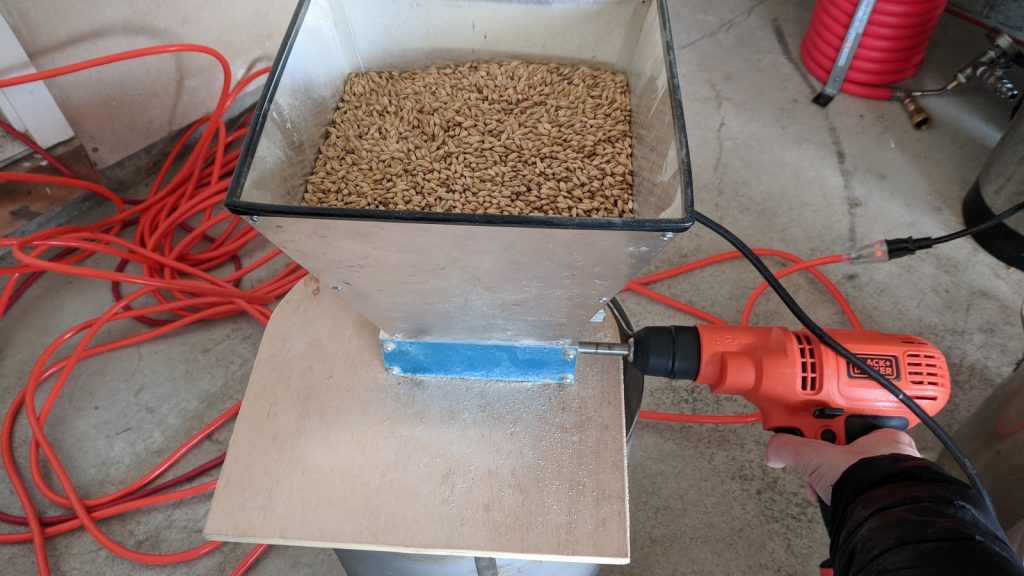
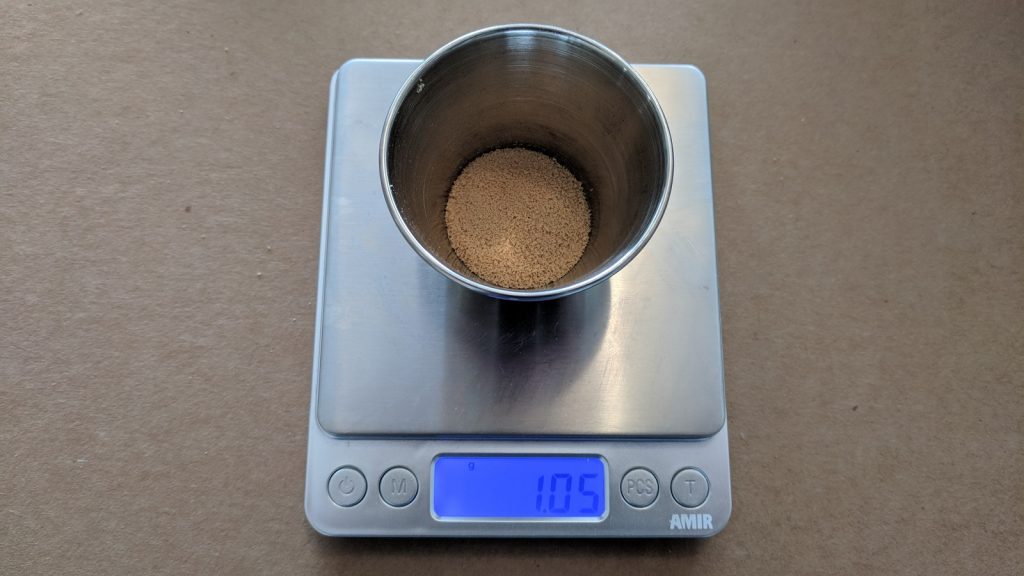
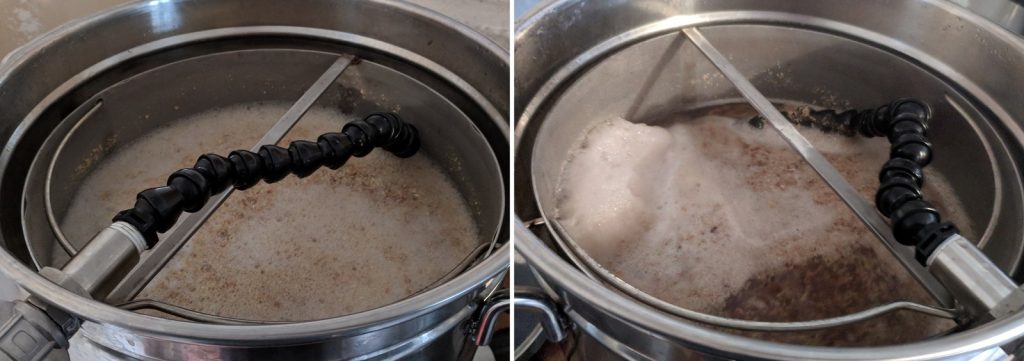
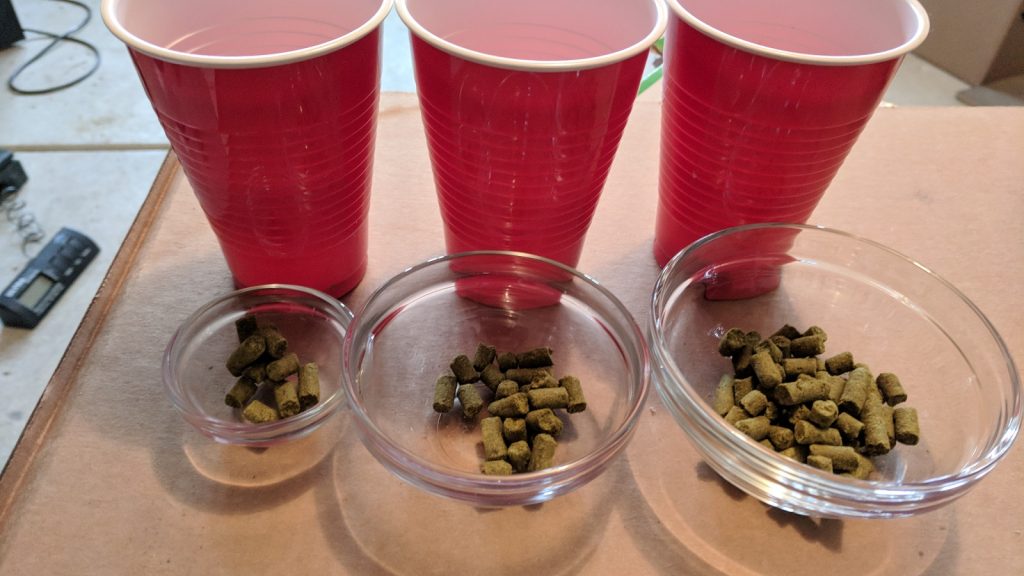
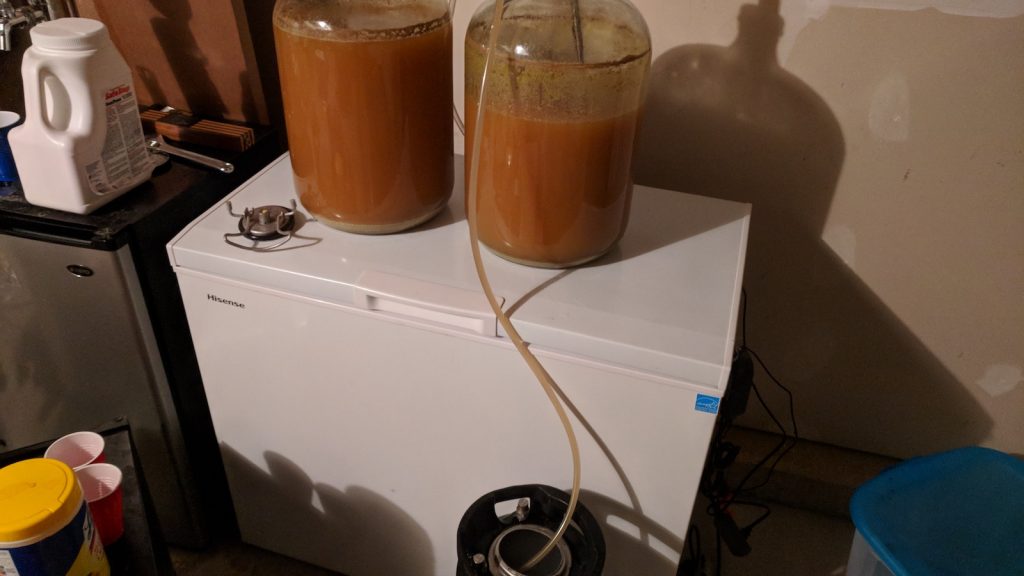










27 thoughts on “exBEERiment | Immediate Impact Using Brewtan B Has On An American Pale Ale”
Aww, there’s an XML error (XML not retrieved: Not found.) probably related to the BeerXML recipe, which does not show up. Cheers!
Dang, thanks for the heads up!
It would be interesting to test this product on a NEIPA. Although clarity is not necessarily a desired affect, oxidation seems to play a large impact on these beers. Maybe a xbrmt aging a NEIPA for a few months before testing. See if the dosed batch stays bright or starts to turn that purple brown they are known to get.
Also, any chance you saved some of this beer to test later, like a month(s)? I’d like to know if the beer ever cleared or started to taste different in your opinion. Thanks for the xbrmt.
I agree! Seeing the impact on different styles is something I’m super interested in, I’ve used it in a few other beers since and I’ll be able to report on those (anecdotally) in a bit once they have all conditioned and been tasted.
And seeing the beers again in several months is on the list!
The product wasn’t intended to produced a flavor difference. The test should have been to store the samples for at least 4 months and then do the taste test.
It may not be the intention of the product, but tasters were able to tell them apart so there may be something to it.
And that is also on the list!
agreed.
I agree with Will a above, especially an NEIPA with a significant amount of oats in the grain bill, which can accelerate oxidation.
You already mentioned you’ll “age” this for a bit and test again. Have you thought about also filling a couple of bottles from each keg and aging these side by side as well? Bottling would likely introduce more oxygen than just leaving the beers in purged kegs and might show more of a difference. Also it would be interesting if using Brewtan B increases stability/shelf life of beers bottled from kegs. Or even better, if it would help with oxidation issues bottle conditioning hoppy beers, since the general consensus seems to be that kegged hoppy beers are better than bottle conditioned hoppy beers.
Nice exbeeriment!
That is an awesome idea, love it. It will need to be a new batch, just because of existing volume, but I’ll definitely put this on my list.
I’m curious to see the results after the beers have aged a bit and to see if there is any difference.
Also, I don’t see a recipe attached with this article…
Same! On the list.
And that is really weird, thanks for the heads up. I’ll look into it.
Some staling and oxidation can definitely add to the flavour experience. Like oxidised sherry (which can still be vibrant) or cask ales on the second day of pulling.
hey matt. what is the biab basket you are using, and where did you get it?
keep up the great work.
The SS grain basket came with the V2 Unibrau, so I got it that way. They’re available on ebay and similar under a few different names.
Some additonal data points…
https://www.experimentalbrew.com/experiments/brewtan-or-do-oxygen-scavenging-chemicals-change-beer-character
https://www.experimentalbrew.com/experiments/writeups/writeup-brewtan-or-do-oxygen-scavenging-chemicals-change-beer-character-updated
https://www.experimentalbrew.com/podcast/episode-25-brewtan-your-questions-away
Thanks for linking those resources Denny! Great to get other perspectives and data points.
I’m my process I add Brewtan B at 15min in the boil and Whirfloc at 10. This instruction was given in a discussion forum Denny Conn started.
Hey James!
I saw that, I believe the recommendation was from Joe F. who works for the company who produces BTB (I believe he says 16 minutes, eh).
For the purpose of this experiment, since it was our first pass at it, I decided to follow the manufacturer recommendations. They suggest adding BTB a maximum of five minutes before the end of the boil.
Definitely plan on exploring this one more!
I am wondering how this product BrewTan B compares and is perhaps possibly the one and same by Laffort Labs called Tanin Galalcool link: https://www.laffort.com/en/products/tannins/224 I ask since we have this at our winery and have used it in winemaking. This product works nearly the same and maybe they are the same?? Thought?
Vern
Of those who were correct on the triangle test, “2 perceived no difference between the beers.” That’s interesting. I suppose it means 2 people just guessed at random and happened to be right? Intuitively, I wouldn’t count this as the taster really noticing a difference in the triangle test. They had to pick something and just got lucky. Is there a way to factor this out statistically?
I see this in all the exbeeriments and have wondered this as well. Shouldn’t you negate those tasters and the variable being tested would be considered insignificant?
Marshall can speak more to this, or we can reach out to some of the guys we talk with about stats, but my understanding is that “guessing” is actually built into the stats model for triangle tests. Some people are going to guess and get lucky, if they can’t tell a difference.
That preference data is all anecdote, not related to the test itself really, just sort of “fun” information.
Yep, that’s what I was thinking too. I’m no statistician, but another option might be to require a lower p-value for significance. Some social scientists have proposed changing the standard from .05 to .005 (see the paper here: https://www.nature.com/articles/s41562-017-0189-z). The downside would be fewer significant exbeeriment results. Glad to see Matt’s comment, as I’d love to hear what Marshall or the stat guys think.
Matt – have you re-tasted the beers recently? Interested to see how age has affected them.
Same question as Brew5ter, above.
I’m interested in Brewtan B for malt-forward beers (namely, German Lagers), especially when it comes to aging. I’d love to see a similar experiment that focuses on a lagered, malt-forward beer.
Matt, would be interesting to see you run this experiment again, but without leaving whirlfloc out. It’s my finding that BrewTan B for clarity purposes, works much much better with the combination of a fining agent, though if you add BrewTan B to boil, you need to wait 5 minutes before fining. I use a gram of BTB in mash and 0.75 grams at 15 mins in boil (due to copper chiller) and get crystal clear wort after chilling, and then crystal clear beer after cold crashing post fermentation and then once in keg, it’s usually clear after the first pint, So clear, that it looks like it a professionally filtered beer,